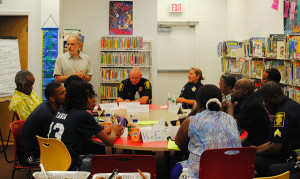
Health literacy is defined in the Affordable Care Act as the ability to obtain, communicate, process, and understand basic health information and services to make appropriate health decisions. Health literacy takes many forms, from understanding the instructions on a prescription bottle or a consent form to knowing when and how to get a second opinion.
Unfortunately, according to Christian Minter, NLM Associate Fellow at Welch Library, Johns Hopkins University, 36% of adults in the US (87 million people) have basic or below basic health literacy. Low health literacy leads to $106 to $236 billion in health care costs annually because of higher use of emergency rooms, longer hospitalizations, and other issues, many of which are preventable.
Minter and her fellow panelists at “Public Health and Public Libraries: Librarians as Health Literacy First Responders” said public librarians are well equipped to respond to this crisis. Libraries can provide the space, technology, and resources to help improve health literacy.
More and more people are turning to the internet for health information—59% of adults last year sought health information online—but most users can’t say for sure what makes a good or a bad healthcare website. For example, the recent resurgence of measles is due to poor health literacy, said Anita Kinney, data analyst at Prince George’s County Memorial Library System. Studies show that up to a third of parents still believe vaccines cause autism. “It is incumbent on libraries to promote reliable resources,” she said.
Libraries can also advocate for health promotion—the process of enabling people to improve and increase the control over their health. She cited the Back to Sleep education campaign to combat SIDS, which reduced infant death rates by 50%. Libraries that serve communities with high rates of specific diseases (diabetes, spina bifida) can create programming to address issues such as cultural disparities in care and cultural differences in diet.
“You are doing public health work every time someone comes to your library with a word on a slip of paper and says, ‘My doctor says I have this,’” said Carrie Banks, supervising librarian at the Child’s Place for Children with Special Needs, Brooklyn Public Library.
Lydia Collins, consumer health coordinator with the National Network of Libraries of Medicine (NN/LM), encouraged forming partnerships between libraries and other organizations in the community, even with limited resources. “Not everyone can have an airport kiosk. But there are other opportunities for outreach,” she said. She asked: What kinds of partnerships would be beneficial in your area? Who isn’t coming into your library? Why aren’t they coming? How do you get them in?
Collins cited several free classes offered online and in person by NN/LM on consumer health for librarians and provided examples of some successful local programs:
- A library in Delaware had a healthy cooking program to fight high diabetes rates in seniors.
- Libraries in South Carolina partnered with hairdressers and barber shops to use Medline to provide health information to customers.
- On the state level, New Hampshire trained 100 public librarians on Medline Plus to better answer patrons’ questions.
Other organizations Collins suggested libraries could partner with included the YMCA, private medical and dental practices, faith-based organizations, health ministries, boys/girls clubs, hospitals, clinics, agencies on aging, local or regional disease agencies, universities, nutrition and nursing programs, and mental health facilities.
Librarians have credibility and trust in communities that other organizations don’t, the panelists noted. Teens may be more comfortable hearing about pregnancy prevention from a local organization at the library than they would at school or another facility, for example.


